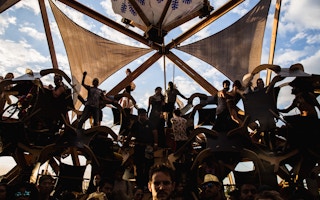Tapping into the power of art to inspire social responsibility and awareness of sustainability, Thailand’s pioneering lifestyle and music festival, Wonderfruit, is bringing architectural innovation to the new grounds of the annual celebration this year.
To continue reading, subscribe to Eco‑Business.
There's something for everyone. We offer a range of subscription plans.
- Access our stories and receive our Insights Weekly newsletter with the free EB Member plan.
- Unlock unlimited access to our content and archive with EB Circle.
- Publish your content with EB Premium.
The fifth instalment of Wonderfruit, which has incorporated a unique blend of festival and museum art into its built structures, is set to take place in a bigger location within the grounds of Siam Country Club.
Surrounded by mountains and the lush greenery of the Thai countryside, the festival continues to pave the way for sustainability by preserving the natural environment and using locally sourced bamboo as a foundation for its venues, stages, art installations and architectural structures.
A zero single-use plastic policy will continue to be implemented throughout the four-day, carbon-neutral festival while the materials used for building and serving food are biodegradable.
“This year the line is blurred between art and architecture, and the built structures serve as both,” said Pete Phornprapha, founder and chief executive of Wonderfruit. “Like always, all our art represents or has a dialogue with our ethos, which are structured along themes such as land, waste, water, food and farm. The way people interact with them is going to be exciting.”
“
“This involves thinking about how things are built and not just how they look. What are the cultural, economic and environmental processes involved?”
Pete Phornprapha, founder and CEO, Wonderfruit
A few of the art and architecture features include the Eco-Pavilion, a sheltered structure designed by London-based studio Ab Rogers Design and made up of a hundred handcrafted cotton umbrellas produced by local brand Chiang Mai Umbrellas, and the iconic Solar Stage, a geometrical installation crafted by Los Angeles-based architect Gregg Fleishman using sustainably harvested wood. The stage, which serves as the focal point of Wonderfruit each year, is assembled and taken apart at the end of the festival to be reused and redesigned the following year.
On building as simply as possible for Wonderfruit, Phornprapha tells Eco-Business: “This involves thinking about how things are built and not just how they look. What are the cultural, economic and environmental processes involved? We like to see how simple and effective these things can be and how they can preserve and not destroy the environment.”
According to Phornprapha, Wonderfruit does its best to engage with local artists and works with craftsmen and workers from Chonburi province, where the festival has annually taken place since it first began in 2014.
One of the local artists includes Bangkok-based Ruangsak Anuwatwimon, who created ‘Islands’, an experiential space housing monuments in the shape of icebergs. ‘Islands’ encourages festival-goers, dubbed Wonderers, to explore the relationship between humans and nature by contemplating the significance of water and current issues related to the world’s key natural resource.
Structured according to six pillars—art and architecture, family, farm to feasts, music, talks and workshops, and wellness—Wonderfruit hopes to champion innovation and positive social impact by offering new, immersive experiences to its Wonderers. As such, the team has introduced Wonder Kitchen, which allows diners the opportunity to watch local masterchefs Phanuphon Bulsuwan and Chudaree Debhakam at work and even learn how to make cocktails out of food scraps and enjoy a zero-waste bar.
“When people see you as a festival, people automatically assume it must be a music festival,” said the other half of Wonderfruit’s founding duo, Montonn Jira, in a recent podcast. “With the whole concept of pillars, we’ve wanted to make sure the chefs were headlined as big as the music acts, along with the artists, architects and guest speakers.”
The festival’s other food offering, the Theatre of Feasts, designed by United Kingdom-based Ab Rogers, hosts a unique banquets for as many as 200 people each year. The concept is said to be inspired by the idea of architectural structures being defined by the experiences they create and the activities being held within them.
“As we build up our pop-up city, we have plans to involve the lands and the structures to work together. But to be sustainable for me doesn’t just involve how we work with the land, but what we do on it as well,” said Phornprapha.










